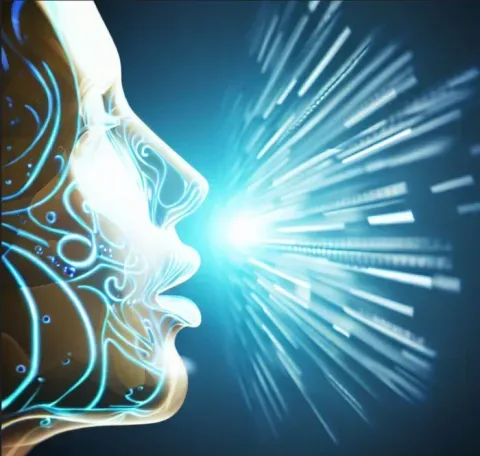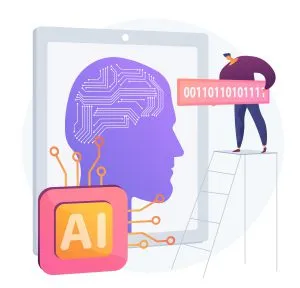Can language be mastered with algorithms?
Ah, the stark irony in this sentence is a highly debatable topic, making the answer to this question less significant.
Linguistics marrying mathematics is a complex affair, not just because of the different dynamics of these fields but due to their core foundational essence. Think back to school days, when some of us excelled in languages but struggled with numbers or vice versa. Not many find a perfect balance between these two fields (or abilities).
But artificial intelligence (AI) aims to achieve that balance. It strives to make human-machine interactions smoother by decoding and identifying spoken languages and converting them into text.
The recent advancements backed by AI and Machine Learning around integrating grammar, structure, accents, syntax, dialects, and adaptability have streamlined the pace and efficacy of human-computer interaction (HCI). It has revolutionised the overall modern communication experience.

What’s and Whys About Speech Recognition
Automatic Speech Recognition (ASR) or computer speech recognition is a machine’s ability to convert human speech into a written format, hence the name Speech-to-Text. However, it is quite often confused with voice recognition.
Voice recognition technology primarily focuses on identifying individual user voices using biometric technology.
Think of speech recognition as the initial trigger that enables voice technology to perform smoothly. We owe it to ASR technology for the quick, fun, and adaptive responses of Alexa, Cortana, or Siri (our beloved voice assistants!). Had it not been for speech recognition and its advancements, our speech would have been just audio recordings to the computers—even today.
Now, let’s take a glance at how Speech Recognition functions: analysing the audio, breaking it into smaller parts, converting it into a machine-friendly (readable) structure, and finally using algorithms to interpret it for producing the most apt text presentation.
This technology is assessed on its accuracy rate, viz., speed and word error rate, or WER. Factors such as accent, volume, pronunciation, background noise, industry-specific jargon, etc., directly affect the WER.
A few speech recognition algorithms and computation techniques:
- Natural Language Processing (NLP),
- Hidden Markov models (HMM),
- Neural networks,
- N-grams,
- Speaker Diarization (SD).
ASR has become a highly innovative and speculative field generating metadata across sources. As per Gartner’s predictions- 25% of employee interactions with various applications will be mainly via voice by 2023.
A few main reasons behind its growing popularity are:
- High Speed
- Predictive outcomes (or analytics) it can deliver
- Its role in accelerating automation
- Its ability to cater exceptionally well to the rapidly growing “remote world”.
What makes speech recognition challenging?
Why is speech recognition hard?
Our language is arbitrary. Hence, its peculiarities and complexities make it very challenging for the machine to analyse and produce error-free transcription. Further, the involvement of various abbreviations, syntaxes, acronyms, phrases, dialects, accents, context, semantics, pragmatics, etc., poses dilemmas limiting ASR’s efficacy, efficiency, and accuracy.
The biggest speech recognition challenges:
1) Imprecision and Misinterpretations: Context is key!
To master this, the machine would have to learn but, most importantly, understand the difference between hearing and listening. While communicating, we take into account the speaker’s expressions, body language, tone, and pitch and then determine the meaning (as well as the sentiments behind it).
But for the machine, it is a tough spot since they lack contextual experience (and sentiments) and run solely on algorithms.
2) Background Noise: It hinders accuracy big time
Loud surroundings and background noise make speech recognition unreliable and unfit for large public spaces. The technology lags in mitigating and filtering background noises to isolate the human voice. Hence, additional external devices (like headsets) can help in this scenario. But that is just too much extra baggage. Another aid here is acoustic training, but it has its limitations too.
3) Language Base: The more, the merrier!
The current gap in language coverage provides a barrier to adoption. The large number of varying accents and dialects is among the major factors impacting accuracy. That’s why we not only need more languages in the arena but also need to include more accents and dialects. It can help by providing more exposure, experience, and learning opportunities for the machine.
4) Data Security and Privacy: Cost and implementation
For a machine to learn and train, massive data input is required. The current approach to obtaining data via paid research or studies is very restricting. It forms a fraction of the total voice data generated in this digital age. Accessing, using, and managing the collected data raises questions about data security and individual user privacy.
This conflict of interest narrows the availability of the data inputs required for AI, making data accessibility even harder.
Wrap-Up
Speech recognition technology is an inclusive package deal a user gets with any modern digital experience (that’s how embedded it has become). This evolving technology revolves around adaptability, paving the way for more unique use cases.
Human’s quest to streamline human-machine interaction has come a long way. Sure, it ain’t perfect at the moment (nothing is!). But who knows what the future holds?
Share your thoughts in the comments below!

